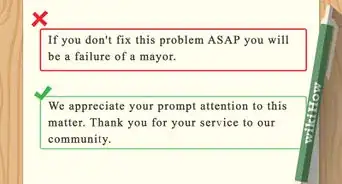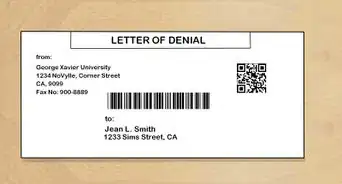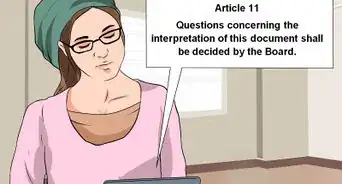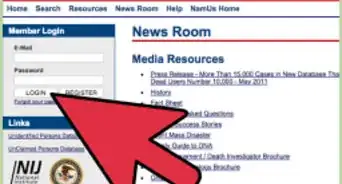This article was co-authored by Clinton M. Sandvick, JD, PhD. Clinton M. Sandvick worked as a civil litigator in California for over 7 years. He received his JD from the University of Wisconsin-Madison in 1998 and his PhD in American History from the University of Oregon in 2013.
There are 9 references cited in this article, which can be found at the bottom of the page.
wikiHow marks an article as reader-approved once it receives enough positive feedback. In this case, 81% of readers who voted found the article helpful, earning it our reader-approved status.
This article has been viewed 82,633 times.
In order to create a law in the United States, the legislature must first pass a bill. The legislature consists of two chambers, the Senate and the House of Representatives. A bill, which is legislation that may or may not become law, can be introduced in either chamber and must go through a series of steps before it can be given to the President to sign. If you are trying to track a piece of legislation in order to understand how far along in the process it is, you can talk to members of Congress or you can use some of the online resources available to you.
Steps
Understanding the Legislative Process
-
1Introduce a bill. Any congressperson or senator can introduce a bill to their respective chamber of the legislature.[1] When a bill is introduced, the person introducing it will be considered the bill's sponsor, and the bill will receive a number.[2] If a bill is introduced in the House of Representatives, it will receive an "H.R." designation.[3] If a bill is introduced in the Senate, it will receive an "S." designation.[4]
-
2Refer the bill to an appropriate committee. Once a bill has been introduced in either the Senate or the House, it will be referred to an appropriate committee within that legislative chamber.[5] The specific committee a bill will be referred to will depend on the subject of the bill, the chamber of the legislature it was introduced in, and the rules that must be followed.
- For example, assume a bill is introduced in the Senate, and the subject of the bill is education, and the rules state that the Parliamentarian will choose the committee it gets referred to. If this is the case, the bill is likely to be referred to the Senate Committee on Health, Education, Labor, and Pensions.[6]
Advertisement -
3Review the bill in committee and/or subcommittee. Once a bill is referred to a committee, it will be put on the committee's calendar.[7] When a bill is up for consideration in a committee, the committee may choose to refer the bill to a subcommittee or it may choose to debate the bill itself.[8] If a bill is passed on to a subcommittee, that subcommittee will review the bill and determine its chances of success.[9]
- If a committee does not act on a bill, it will die and another bill will have to be introduced.[10]
-
4Mark up the bill. Once a subcommittee or full committee has had a chance to review the bill, the committee or subcommittee will usually hold public hearings about the bill.[11] At public hearings, committee members will hear oral testimony from people about the bill.[12] After the public hearings are done, the committee or subcommittee will take part in what is known as the "mark-up session."[13] During the mark-up session, committee members will look at the bill, the testimony, and any other information they have, and they will amend the bill if they feel it is necessary.[14]
-
5Report the bill. Once a bill has been reviewed and marked up, the committee or subcommittee will vote on the bill.[15] A committee may vote to table a bill or report it.[16]
- If a committee votes to table a bill, that means the committee will take no further action on the bill and it will not be referred along.[17] If this happens, the bill will die and a new bill will have to be introduced.
- If a committee votes to report a bill, a Committee Report will be written.[18] A Committee Report describes the purpose and scope of the bill and the reasons for recommended approval.[19]
-
6Debate the bill. Once a bill has been reported, it will be put on the Senate or House calendar, depending on where the bill originated.[20] When a bill's date comes, the bill will be introduced to the entire chamber of the legislature where the bill originated, and that chamber will debate the bill.[21]
-
7Vote on the bill. Once a bill has been debated in one of the chambers of the legislature, that chamber will vote on the bill.[22] After the vote, the bill will either have passed or been defeated.[23]
- If a bill is defeated, it will be considered dead and a new bill will have to be introduced.
- If a bill is approved, it will be referred to the other chamber of Congress.
-
8Repeat the process in the other chamber of Congress. Once a bill is referred to the other chamber of Congress, the entire process discussed above will be repeated, this time in the other chamber.[24]
- If, after the process is completed, the bill is defeated, the bill will be considered dead and a new bill will have to be introduced.
- If, after the process is completed, the bill is approved, it will be sent to the President of the United States of America.[25]
-
9Allow the President to make a decision. Once a bill has been approved by both chambers of Congress, the President will have to sign the bill into law or veto the bill.[26]
Tracking Legislation With THOMAS
-
1Learn about the THOMAS resource. THOMAS was created, at the direction of Congress, in order to make legislative information available to the public.[27] While THOMAS does not stand for anything in particular, it was named after Thomas Jefferson. THOMAS is a government resource, and therefore the information contained within it is going to be objective, straightforward, and sometimes quite dry. While it is a great resource, if you are looking for opinions and write-ups on legislation, you may want to use one of the other resources available to you. If you are looking for straightforward facts about where a bill is being debated, or when a committee has a hearing, this might be a great site for you. Some websites, including GovTrack, will use information found on THOMAS.[28] If you use THOMAS, you will be able to find information about:
- Bills and resolutions;
- Activities in Congress;
- Congressional records;
- Schedules and calendars; and
- Committee information.[29]
-
2Visit the Library of Congress THOMAS website. If you think THOMAS may be able to help you track legislation, start by visiting the THOMAS site. On the home page you can access all of the information you will need.
-
3Search for anything that interests you. Once you access the THOMAS site, you can track legislation in any number of ways.
- You can search for legislation by typing in a bill's number. For example, if you are looking for "H.R. 5", you can simply type that into the search box.
- You can search for legislation by using keywords. For example, if you are looking for legislation about education, then type education into the search box.
- You can search for a bill by who sponsors it. For example, if you want to look up legislation sponsored by your senator, simply find your representative using the THOMAS site.
- You can also see what the most current activity in Congress is by simply navigating the THOMAS home page.
- You can also see what the most popular topics are on the THOMAS site by looking at THOMAS' popular topics.
-
4Analyze your results. Once you find a bill and you want to understand where in the process that bill is, you can look at the information THOMAS provides you. In general, THOMAS will provide you with the following:
- The text of the legislation;
- The committees that have considered it;
- The latest title;
- Any sponsors and co-sponsors;
- Any related bills;
- The latest major action taken on the bill; and
- All action taken on the bill from its introduction to where it stands today.
Tracking Legislation with GovTrack
-
1Learn about GovTrack. GovTrack, which is similar to Open Congress, is probably the most visited legislation tracking website available.[30] Not only does GovTrack give you the ability to track legislation, but it also allows you to track your representative's voting record.[31] Unlike OpenCongress, GovTrack is run by a for-profit LLC.[32] GovTrack has a website, Twitter handle, Facebook page, and a blog.[33] If you are busy and wish to have the tracking work done for you, GovTrack is probably the best site for you. GovTrack offers a service that will send you email updates as bills move through the legislative process.[34]
-
2Visit the GovTrack website. To start tracking legislation with GovTrack, go to their website. If you want to get email updates, you will need to register and create an account with GovTrack.
-
3Search for anything that interests you. Once you have accessed the GovTrack website, you will have the ability to search for legislation in the following ways:
- You can look at what is on the Senate and House calendar for any given day.[35] This is helpful if you simply want to know what Congress is doing on any given day.
- You can browse bills by subject matter.[36] If you are interested in a certain subject (e.g., education or agriculture), but not necessarily a particular bill, this may be the best way to search.
- Unique to GovTrack, you can browse legislation by status, which means you can see what bills have failed, passed a vote, and/or been enacted.[37]
- You can also ask for email updates for major legislative activity, legislation coming up, new laws, all legislative activities, or GovTrack bill summaries.[38]
-
4Analyze your results. Once you find a bill, GovTrack will provide you with all the basic information that THOMAS and OpenCongress does. In addition, GovTrack will provide you with a prognosis, which is the percentage chance the bill has at being enacted. GovTrack also gives you the contact information necessary to call or email the important legislators about the bill.
Tracking Legislation With OpenCongress
-
1Learn about OpenCongress. OpenCongress allows anyone to to follow legislation in Congress, from a bill's introduction through voting. OpenCongress is operated by the Sunlight Foundation, which is a nonpartisan nonprofit organization that advocates for a transparent government. Unlike THOMAS, OpenCongress is much more user friendly and interactive. When you use OpenCongress you can compare voting records, rate your support or opposition to a piece of legislation, and you can register with the site and interact with other users.
-
2Visit the OpenCongress website. If you are wanting to not only track legislation, but also interact with other interested parties and become involved in the process, you can start by opening the OpenCongress homepage.
-
3Search for anything that interests you. Once you access the OpenCongress website, you can enter a lawmaker's name, issue topic, or bill number. If you are a registered user, you can track bills and receive updates about actions being taken, and you can connect and talk to other registered users on the site as well.
- Also, without even having to conduct a search, the home page provides you with the most recent activity taking place in Congress, as well as the most popular searches on the site.
-
4Analyze your results. Unlike THOMAS, OpenCongress provides your results in an incredibly easily digestible manner. Once you click on a bill you are interested in, it will provide you with an overview, which includes a graphic showing you where in the process the bill is. Also, in addition to providing all the information THOMAS does, OpenCongress also provides you with letters to Congress about the bill. These letters, written by concerned citizens, either oppose or support the bill and state their reasons why. If you are a registered user, you can even write a letter to Congress voicing your opinion.
References
- ↑ http://congress.org/advocacy-101/the-legislative-process/
- ↑ http://congress.org/advocacy-101/the-legislative-process/
- ↑ http://congress.org/advocacy-101/the-legislative-process/
- ↑ http://congress.org/advocacy-101/the-legislative-process/
- ↑ http://congress.org/advocacy-101/the-legislative-process/
- ↑ http://www.help.senate.gov/
- ↑ http://congress.org/advocacy-101/the-legislative-process/
- ↑ http://congress.org/advocacy-101/the-legislative-process/
- ↑ http://congress.org/advocacy-101/the-legislative-process/
- ↑ http://congress.org/advocacy-101/the-legislative-process/
- ↑ http://www.house.gov/content/learn/legislative_process/
- ↑ http://www.house.gov/content/learn/legislative_process/
- ↑ http://www.house.gov/content/learn/legislative_process/
- ↑ http://www.house.gov/content/learn/legislative_process/
- ↑ http://www.house.gov/content/learn/legislative_process/
- ↑ http://www.house.gov/content/learn/legislative_process/
- ↑ http://www.house.gov/content/learn/legislative_process/
- ↑ http://www.house.gov/content/learn/legislative_process/
- ↑ http://www.house.gov/content/learn/legislative_process/
- ↑ http://congress.org/advocacy-101/the-legislative-process/
- ↑ http://congress.org/advocacy-101/the-legislative-process/
- ↑ http://congress.org/advocacy-101/the-legislative-process/
- ↑ http://congress.org/advocacy-101/the-legislative-process/
- ↑ http://congress.org/advocacy-101/the-legislative-process/
- ↑ http://congress.org/advocacy-101/the-legislative-process/
- ↑ http://congress.org/advocacy-101/the-legislative-process/
- ↑ http://thomas.loc.gov/home/abt_thom.html
- ↑ https://www.govtrack.us/about
- ↑ http://thomas.loc.gov/home/abt_thom.html
- ↑ https://www.govtrack.us/about
- ↑ https://www.govtrack.us/about
- ↑ https://www.govtrack.us/about
- ↑ https://www.govtrack.us/about
- ↑ https://www.govtrack.us/about
- ↑ https://www.govtrack.us/congress/bills/
- ↑ https://www.govtrack.us/congress/bills/#subjects
- ↑ https://www.govtrack.us/congress/bills/#bystatus
- ↑ https://www.govtrack.us/congress/bills/#docket



















































































